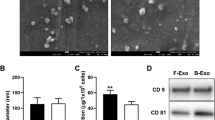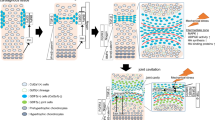Summary
The effect of niflumic acid on hyaluronic acid and proteoglycan metabolism of human cartilage cells was investigated in vitro. Cartilage cells were obtained from five different donors. Niflumic acid levels used in the test systems ranged from 0 to 22 μgr/ml and were comparable to serum concentrations in humans after oral intake. Niflumic acid increased the synthesis rates of proteoglycan in some batches of isolated and monolayer-cultured chondrocytes. The effect on hyaluronate synthesis was less pronounced. The fact that this increase in the synthesis of proteoglycan was restricted to some of the donors whereas isolated cells or tissue samples from other individuals remained unaffected illustrates the heterogeneity of different human donors. Depression of proteoglycan synthesis in the presence of the drug was never observed.
Similar content being viewed by others
References
Kempson, G.E., Muir, H., Pollard, Tuke M. The tensile properties of the cartilage of human femoral condyles related to the content of collagen and glycosaminoglycans. Biochem Biophys Acta 1973, 297, 456–472.
Kempson, G.E., Muir, H., Swanson, S.A.V., Freeman, M.A.R. Correlations between stiffness and the chemical constituents of cartilage on the human femoral head. Biochem Biophys Acta 1970, 215, 70–77.
Libby, W.F., Berger, R., Mead, J.F., Alexander, G.V., Ross, J.F. Replacement rates for human tissue from atomospheric radio-carbon. Science 1964, 146, 1170–1172.
Maroudas, A. Glycosaminoglycan turnover in articular cartilage. Phil Trans Soc London (B), 1975, 271–313.
Wilhelmi, G., Maier, R. Experimental studies on the effects of drugs on cartilage. In: Articular Cartilage and Osteoarthrosis, Bern, Hans Huber Publishers, 1983, pp. 42–64.
Brandt, K. Drug-induced changes in cartilage. Do NSAID's influence the outcome of degenerative joint disease? In: Degenerative Joints, Vol II, Editors: Verbruggen, G., Veys, E.M., Amsterdam, Excerpta Medica, 1985, 315–320.
Kalbhen, D.A. Degenerative joint disease following chondrocyte injury — Chemically induced osteoarthrosis. In: Degenerative Joints, Vol II, Editors: Verbruggen, G., Veys, E.M., Amsterdam, Excerpta Medica 1985, 299–309.
Wilhelmi, G. Fordernde und hemmende Einflüsse von Tribenosid und Acetylsalicylsaure auf die spontane Arthrose der Maus. Arzneimittelforsch 1978, 28, 1724–1726.
Palmoski, M.J., Brandt, K.D. Effect of salicylates on proteoglycan metabolism in normal canine articular cartilage in vitro. Arthritis Rheum 1979, 22, 746–754.
Kalbhen, D.A. EInfluss antirheumatischer Pharmaka auf den Gelenkknorpel. Akt Rheumatol 1982, 7, 211–217.
Palmoski, M.J., Brandt, K.D. Effects of some nonsteroidal anti-inflammatory drugs on proteoglycan metabolism and organisation in canine articular cartilage. Arthritis Rheum 1980, 23, 1010–1020.
Ronningen, M., Langeland, N., Indomethacin treatment in osteoarthrosis of the hip joint. Does the treatment interfere with the natural course of the disease? Acta Orthop Scand 1979, 50, 169–174.
Brandt, K.D., Slowman-Kovacs, S. Nonsteroidal anti-inflammatory drugs in the treatment of osteoarthritis. Clin Orthop Rel Res 1983, 213, 84–91.
Mohr, W., Kirkpatrick, C.J., Wildfeuer, A., Leitold, M. Effect of piroxicam on structure and function of joint cartilage. Inflammation, 1984 (suppl. 8), 139–154.
Annefeld, M., Raiss, R. Der Einflüss von Piroxicam auf die Ultrastruktur des normalen Chondrocyten in Vergleich zu modernen und klassicher Antirheumatika. Akt Rheumatol 1985, 10, 112–115.
Herman, J.H., Appel, A.M., Khosla, R.C., Hess, E.V. The in vitro effect of select classes of nonsteroidal anti-inflammatory drugs on normal cartilage metabolism. J Rheumatol 1986, 13, 1014–1018.
Verbruggen, G., Veys, E.M., Luyten, F.P. Is a decrease in proteoglycan content in degenerative cartilage exclusively caused by an enzymatical degradation? In: Degenerative Joints Vol II, Editors: Verbruggen, G., Veys, E.M., Amsterdam, Excerpta Medica, 1985, pp. 55–63.
Amor, B., Dougados, M. Internal report 5/04/05.87 UPSA Laboratories, 1987.
Upsa Laboratories — Internal Report. Data on file, 1982.
Green, W.T. Jr. Behaviour of articular chondrocytes in cell culture. Clin Orthop Rel Res 1971, 75, 248–260.
Kuettner, K.E., Pauli, B.U., Gall, G., Memoli, V.A., Schenk, R.K. Synthesis of cartilage matrix by mammalian chondrocytes in vitro. I. Isolation, culture characteristics and morphology. Cell Biol 1982, 93, 743–750.
Verbruggen, G., Luyten, F.P., Veys, E.M. Renewal of intercellular matrix proteoglycans by longterm organ-culture of human articular cartilage. In: Degenerative Joints, Vol II, Editors: Verbruggen, G., Veys, E.M., Amsterdam, 1985, Excerpta Medica, 227–248.
Verbruggen, G., Veys, E.M. Treatment of chronic degenerative joint diseases with a glycosaminoglycan polysulphate. In: International Drug Symposium Arteparon®, Editors: Dettmer, N., Greiling, H., Basle, Eular Publ., 1982, 50–67.
Verbruggen, G., Veys, E.M. Proteoglycan metabolism of connective tissue cells. An in vitro technique and its relevance to in vivo conditions. In: Degenerative Joints, Vol I, Editors: Verbruggen, G., Veys, E.M., Amsterdam, 1982, Excerpta Medica, 113–126.
Verbruggen, G. Unpublished material.
Thonar, E.J.-M.A., Schnitzer, T.J., Kuettner, K.E. Quantification of keratan sulphate in blood as a marker of cartilage catabolism. J Rheumatol 1987, 14 (suppl. 14), 23–24.
Palmoski, M.J., Brandt, K.D. Aspirin aggravates the degeneration of canine cartilage caused by immobilisation. Arthritis Rheum 1982, 25, 1333–1343.
Palmoski, M.J., Brandt, K.D. In vivo effect of aspirin on canine osteoarthritic cartilage. Arthritis Rheum 1983, 26, 994–1001.
Author information
Authors and Affiliations
Rights and permissions
About this article
Cite this article
Verbruggen, G., Veys, E.M., Malfait, A.M. et al. Proteoglycan metabolism in isolated chondrocytes from human cartilage. Influence of niflumic acid. Clin Rheumatol 9, 32–41 (1990). https://doi.org/10.1007/BF02030238
Received:
Accepted:
Issue Date:
DOI: https://doi.org/10.1007/BF02030238




